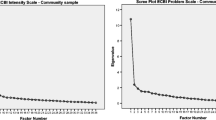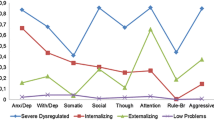Abstract
Empirically defined scales of depressive, attention deficit hyperactivity disorder, oppositional-defiant disorder, and conduct symptoms from the lay-administered National Institute of Mental Health (NIMH) Diagnostic Interview Schedule for Children (DISC), version 2.3, and evidence of their reliability and validity, are presented. The scales were developed using factor analyses of data obtained from an epidemiologic survey of over 1,200 children drawn from four sites across the U.S. and Puerto Rico (the NIMH Methods for the Epidemiology of Child and Adolescent Mental Disorders, or MECA Study). Their psychometric properties were tested in a subsample of children reinterviewed by clinicians. The findings support the use of these continuous measures. The scales are strongly related to the diagnostic categories and show good test-retest reliability. The scales can be used to characterize severity in children with diagnoses and to describe problems and symptoms in children without diagnoses. Because these scales can measure gradations in symptomatology, they may be more useful than categorical measures. Like categorical measures, the scales based on the DISC are greatly influenced by the informant, whether child or parent.
Similar content being viewed by others
References
Achenbach, T. M., & Edelbrock, C. S. (1981). Behavioral problems and competencies reported by parents of normal and disturbed children aged four through sixteen.Monographs of the Society for Research in Child Development, 46 1–25.
American Psychiatric Association. (1987).Diagnostic and Statistical Manual of Mental Disorders (3rd ed., rev.) Washington, DC: Author.
American Psychiatric Association. (1994).Diagnostic and Statistical Manual of Mental Disorders (4th ed.) Washington, DC: Author.
Bauermeister, J. J., Alegría, M., Bird, H. R., Rubio-Stipec, M., & Canino, G. (1992). Are attentional hyperactivity deficits unidimensional or multidimensional syndromes? Empirical findings from a Community survey.Journal of the American Academy of Child and Adolescent Psychiatry, 31 423–431.
Bird, H. R., Canino, G., Rubio-Stipec, M., Gould, M. S., Ribera, J., Sesman, M., Woodbury, M., Huertas-Goldman, S., Pagan, A., Sanchez-Lacay, A., & Moscoso, M. (1988). Estimates of the prevalence of childhood maladjustment in a community survey in Puerto Rico.Archives of General Psychiatry, 45 1120–1126.
Esser, G., Schmidt, M. H., & Woerner, W. (1990). Epidemiology and course of psychiatric disorders in school-age children-results of a longitudinal study.Journal of Child Psychology and Psychiatry, 31 243–263.
Gould, M. S., Bird, H. R., & Staghezza, B. (in press). Correspondence between statistically derived behavior problem syndromes and child psychiatric diagnoses in a community sample.Journal of American Academy of Child and Adolescent Psychiatry.
Harman, H. H. (1976).Modern factor analysis (3rd ed.). Chicago: University of Chicago Press.
Lahey, B. B, Peham, W. E., Schaughenay, E. A., Atkins, M. S., Allen-Murphy, H., Hynd, G., Russo, M., Hartdagen, S., & Lorys-Vernon, A. (1988). Dimensions and types of attention deficit disorder.Journal of the American Academy of Child and Adolescent Psychiatry, 27 30–335.
Lahey, B. B., Flagg, E. W., Bird, H. R., Schwab-Stone, M., Canino, G., Dulcan, M. K., Leaf, P.J., Davies, M., Brogan, D., Bourdon, K., Horwitz, S. M., Rubio-Stipec, M., Freeman, D. H., Lichtman, J., Shaffer, D., Goodman, S. H., Narrow, W. E., Weissman, M. M., Kandel, D. B., Jensen, P. S., Richters, J. E., & Regier, D. A. (1995). The NIMH Methods for the Epidemiology of Child and Adolescent Mental Disorders (MECA) Study: Background and methodology.Journal of the American Academy of Child and Adolescent Psychiatry.
Offord, D., Boyle, M., Szatmari, P., Rae-Grant, N., et al. (1987). Ontario Child Health Study: Six-month prevalence of disorder and rates of service utilization.Archives of General Psychiatry, 44 832–836.
Quay, H. C. (1986). Classification. In H. C. Quay & J. S. Werry (Eds.),Psychopathological Disorders of Childhood (pp. 1–34). New York: Wiley.
Schwab-Stone, M., Shaffer, D., Bird, H. R., Dulcan, M. K., Canino, G., & Regier, D. The NIMH Methods for the Epidemiology of Child and Adolescent Mental Disorders (MECA) Study: Concurrence with clinical assessment. (1995).Journal of the American Academy of Child and Adolescent Psychiatry.
Shaffer, D., Schwab-Stone, M., Fisher, P., Cohen, P., Piacentini, J., Davies, M., Conners, C. K., & Regier, D. (1993). The Diagnostic Interview Schedule for Children Revised Versions (DISC-R): Preparation, field testing, inter-rater reliability and acceptability.Journal of the American Academy of Child and Adolescent Psychiatry, 32 643–650.
Shaffer, D., Schwab-Stone, M., Fisher, P., Davies, M., Piacentini, J., & Gioia, P. (1988). A revised version of the Diagnostic Interview Schedule for Children (DISC-R): Results of a field trial and proposal for a new instrument (DISC-R). (Technical Report).
Shrout, P. E., & Fleiss, J. L. (1979). Intraclass correlations: Uses in assessing rater reliability.Psychological Bulletin, 86 420–428.
Verhulst, F. C., & Van der Ende, J. (1992). Six-year developmental course of internalizing and externalizing problem behaviors.Journal of the American Academy of Child and Adolescent Psychiatry, 31 924–931.
Yager, T. J., Bird, H. R., Staghezza-Jaramillo, B. M., Gould, M. S, & Canino, G. (1993). Symptom counts and diagnostic algorithms as measures of five common psychiatric disorders in children.International Journal of Methods in Psychiatric Research, 3 177–191.
Author information
Authors and Affiliations
Additional information
This research was supported by grant MH-46732 from the National Institute of Mental Health, Bethesda, Maryland.
The MECA Program is an epidemiologic methodology study performed by four independent research teams in collaboration with staff of the Division of Clinical Research, which was reorganized in 1992 with components now in the Division of Epidemiology and Services Research and the Division of Clinical and Treatment Research, of the NIMH, Rockville, Maryland. The NIMH Principal Collaborators are Darrel A. Regier, MD, MPH, Ben Z. Locke, MSPH, Peter S. Jensen, MD, William E. Narrow, MD, MPH, and Donald S. Rae, MA; the NIMH Project Officer was William J. Huber. The Principal Investigators and Coinvestigators from the four sites are as follows: Emory University, Atlanta, Georgia, UO1 MH46725: Mina K. Dulcan, MD, Benjamin B. Lahey, PhD, Donna J. Brogan, PhD, Sherryl Goodman, PhD, and Elaine Flagg, PhD; Research Foundation for Mental Hygiene at New York State Psychiatric Institute (Columbia University), New York, New York, UO1 MH46718: Hector R. Bird, MD, David Shaffer, MD, Myrna Weissman, PhD, Patricia Cohen, PhD, Denise Kandel, PhD, Christina Hoven, PhD, Mark Davies, MPH, Madelyn S. Gould, PhD, and Agnes Whitaker, MD; Yale University, New Haven, Connecticut, UO1MH46717: Mary Schwab-Stone, MD, Philip J. Leaf, PhD, Sarah Horwitz, PhD, and Judith H. Lichtman, MPH; University of Puerto Rico, San Juan, Puerto Rico, UO1 MH46732: Glorisa Canino, PhD, Maritza Rubio-Stipec, MA, Milagros Bravo, PhD, Margarita Alegría, PhD, Julio Ribera, PhD, Sarah Huertas, MD, and Michael Woodbury, MD.
The authors gratefully acknowledge Zenaida González and José Martínez who performed the data nalayses, as well as Elizabeth Pastrana, and Felícita Laboy, secretaries, for their valuable contributions to this work.
Rights and permissions
About this article
Cite this article
Rubio-Stipec, M., Shrout, P.E., Canino, G. et al. Empirically defined symptom scales using the DISC 2.3. J Abnorm Child Psychol 24, 67–83 (1996). https://doi.org/10.1007/BF01448374
Received:
Issue Date:
DOI: https://doi.org/10.1007/BF01448374




